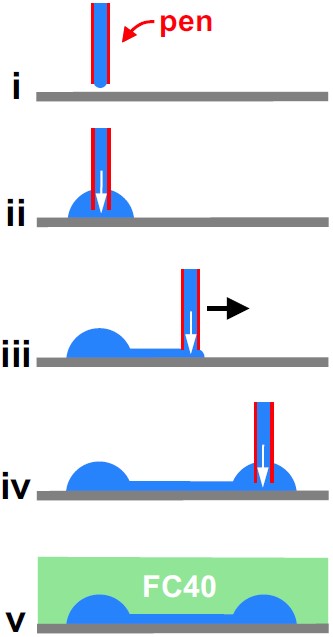Fabrication
Circuits are constructed much like writing freehand on paper (taking much the same time; movie, movie), so we call the approach ‘Freestyle Fluidics’.
They are made as follows (right):
(i) A 'pen' held by a robot will 'print' tissue-culture media on a virgin Petri dish.
(ii-iv) The pen prints the desired pattern (here, two drops connected by a conduit).
(v) An overlay of an immiscible liquid (FC40) prevents evaporation.
Once made, interfacial forces firmly 'pin' the circuit to the dish, and liquid FC40 walls confine the media (background).
Here, the aqueous phase is deposited where wanted. This contrasts with the way GRIDs are made, where FC40 walls are built where wanted.
Operation – flows driven by external pumps
A tube connected to a pump can be inserted into the left-hand drop in the bottom panel (right); the fluid wall spontaneously seals around the inserted tube and starting the pump can drive flow (up to ~1ml/h) to the right. [Example movie.]
Operation – flows driven without using external pumps
Flows can be driven without external pumps by exploiting properties of fluid walls (drops with small radii of curvature harbor higher Laplace pressures that automatically drive flow; movie); this allows cheap multiplexing (e.g., during drug screens).
Panels below illustrate such spontaneous flows (6 cm dishes).
Left panel (‘flower’): Red dye was injected into the bottom of the 'stem'. Laplace pressure drives it up; more distant ‘petals’ fill with progressively less dye. Injecting blue dye into the top does the reverse; the top-most petal gets most blue dye, the bottom one the least.
Second panel (laminar streams): Dyes pipetted into 5 drops (top); Laplace pressure drives laminar flow down the central conduit (each of the 5 streams is a few tens of microns wide, streams do not mix, but dyes diffuse between them).
Third panel (serial dilution): Red/blue dyes pipetted into drops at left/right flow inward; the top-most drop ends up with only red, the bottom-most one only blue, and the middle ones get both (red highest on left, blue highest on right).
Right panel (mixing): Dyes added to outer drops flow to the central one and mix.

|
|
Reference
Walsh, E.J., Feuerborn, A., Wheeler, J.H.R., Tan, A.N., Durham, W.M., Foster, K.R., and Cook, P.R. (2017). Microfluidics with fluid walls. Nat. Commun. 8, 816. [pdf; large pdf with embedded movies; journal] |


![Transcription factories in a Hela cell [from Cook PR (1999) Science 284, 1790]](../images/pombo.png)
